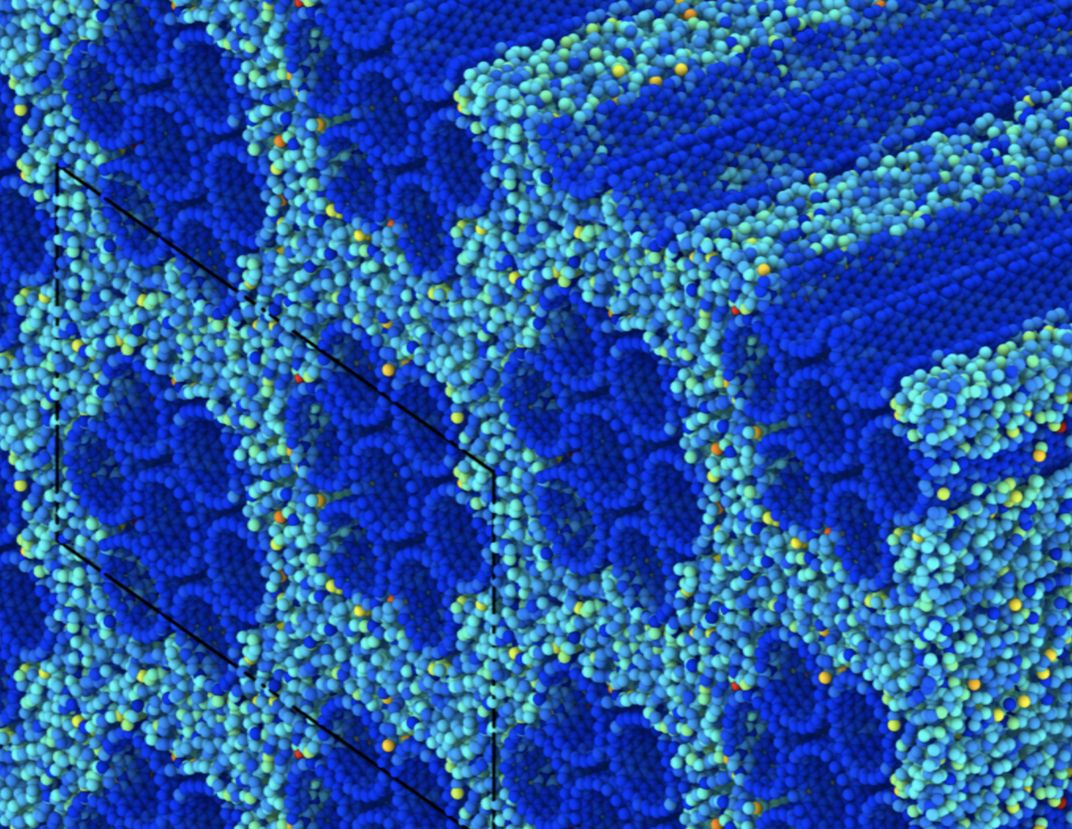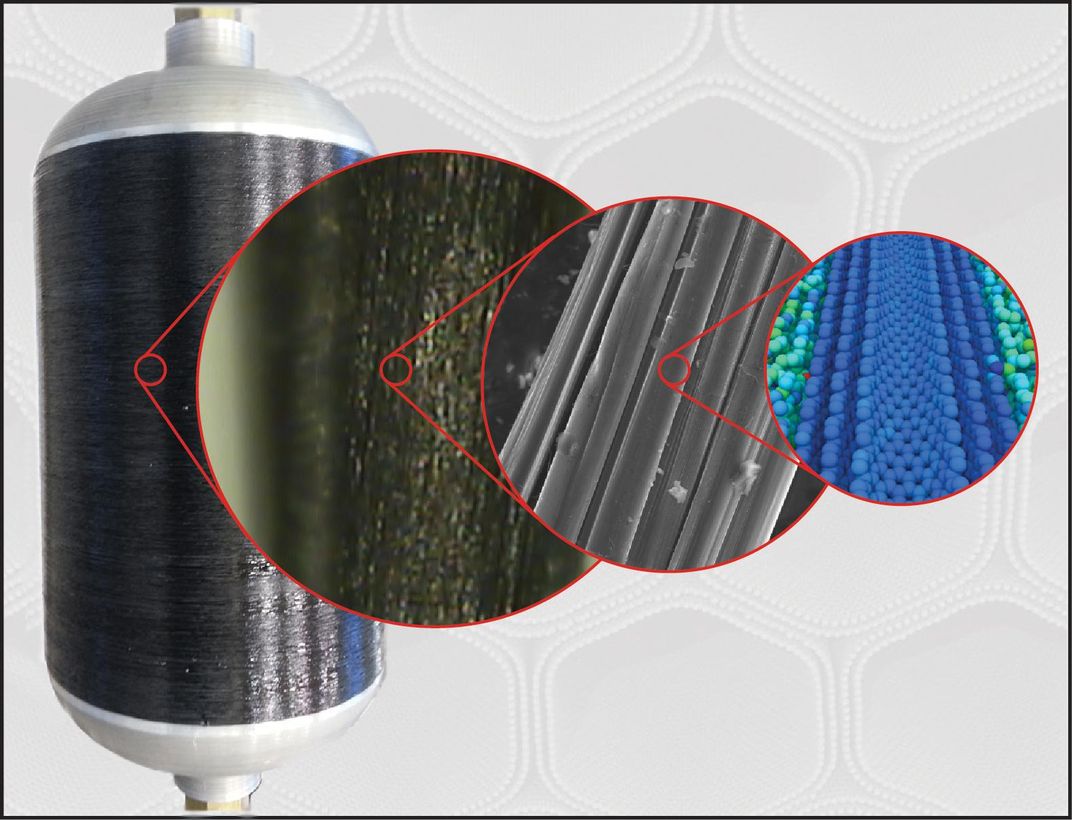Strong Stuff
These students are designing materials tough enough to land on another planet.
/https://tf-cmsv2-smithsonianmag-media.s3.amazonaws.com/filer/af/b4/afb492af-7755-4ca6-8379-bd855d6f64e5/01j_aug2017_michtech6485_live.jpg)
The spacecraft that will one day land humans on Mars will be made of a material that has not yet been invented. Ditto for the rocket that sends them there. But at the end of a $15 million, five-year NASA project set to begin next month, an advanced, high-performance composite will be invented, and it may be the very material used to build those spacecraft. The people inventing it are Ph.D. candidates and other students at 11 universities, all working together.
The project, called the Institute for Ultra-Strong Composites by Computational Design (US-COMP), is led by Michigan Technological University professor Greg Odegard, who assembled the 11-university team of experts in computational mechanics and materials science. The problem NASA has set for them to solve: Use carbon nanotubes to create a composite that is lighter and stronger than any material used in load-bearing structures today. Odegard says high-powered computers at his university and others are the key to success.
“If we want to improve the material that we can already build in a laboratory, we have two options,” he says. “We can go into the lab and keep trying new things until we get it right, but that’s time-consuming and expensive. [Or] we can simulate the materials on a computer and optimize material design much quicker.”
Among other things, the computers will be used to try out changes in the molecular structure of the materials and predict the effect on the material’s mechanical properties—stiffness, toughness, weight, and tensile strength.
Will Pisani is in his first year of work toward his Ph.D. at Michigan Tech, and he’s already started some of the computational modeling the institute will use. During a summer internship at NASA’s Langley Research Center in Hampton, Virginia, Pisani consulted with one of Greg Odegard’s former students, who is now a NASA employee, on the properties of flattened carbon nanotubes.
“When you think of the word ‘tube,’ you think of a cylinder, and that is the shape, most of the time, of carbon nanotubes,” says Pisani. “But some of the experimentalists here at NASA have told me they’re starting to see flattened nanotubes in materials when they image them. And they’re wondering how this happened, what conditions caused the flattening. Is this a good thing?
“I’ve already started creating models of these flattened carbon nanotubes, and I’m looking into the friction force in between them and measuring what that force is.”
The computer technique Pisani is using is known as molecular dynamics, a tool that allows programmers to simulate and predict a structure’s properties and behavior at the molecular scale.
Using molecular dynamics, Matt Radue, who is just about to receive his Ph.D. from Michigan Tech, has created models to simulate the formation or breakage of chemical bonds between atoms; he calculates, by programming Newton’s laws of motion into the models, the velocities and accelerations of the atoms under different conditions, such as changes in temperature.
“Building the model is the hardest step,” says Radue. “It takes about six months, depending on how complex the polymer is.”
Half of the task for the institute is to develop computational methods—such as computer models—to design, predict, and evaluate materials, and participants will be working at many different scales. While Pisani is working at the molecular level, a group at the University of Minnesota specializes in the mesoscale, an area between the atomic and macro worlds, measured in microns, or millionths of a meter.
The other half of the task is “making the materials and testing them to see if the computer designs worked well,” says Odegard. “We’re trying to get the most accurate, efficient computer program to design and evaluate the material before trying it in the lab, but it’s a parallel, not a serial, effort. The experimental folks are waiting for us to give them the computer-designed materials so they can fabricate and test it, but while they’re waiting for that, they’re busy developing their test methods.”
Julie Tomasi loves it when the materials in the lab behave the way the computer models predict. Tomasi, also pursuing a Ph.D. at Michigan Tech, has tested the mechanical, electrical, and thermal properties of epoxy with various embedded fillers, such as graphene (a carbon particle lattice). Dispersion—how well something is distributed in a matrix—is often the challenge, she says. “Will and Matt make computer models, but those aren’t that meaningful if you don’t know if it represents real life,” says Tomasi. “A lot of fillers, carbon nanotubes included, want to stick together if you put them in something else. When they’re all clumped together, it doesn’t improve the mechanical properties at all. But if you have really good dispersion, it will do really great things for the stiffness and strength and all of that,” she says.
At the end of the five years, the teams will produce a panel measuring several feet on a side that can be scaled up to build launch vehicles and spacecraft.
“The next big advancement over carbon fiber-reinforced composites would be making those fibers out of carbon nanotubes, which are very high-strength and very lightweight,” says Steve Jurczyk, the associate administrator for NASA’s Space Technology Mission Directorate, which created the institute. “[Using] carbon nanotube-based materials for load-bearing structures is somewhat unique to NASA.”
Both Jurczyk and Greg Odegard point out that by the end of the five-year technology development program, NASA will get something more than the panel of super-material. “This is also workforce development,” says Odegard. Graduate students at 11 universities will be training to become the next-generation aerospace engineers, who will understand new materials and new computational methods to build the vehicles that will take humans far beyond Earth orbit.



